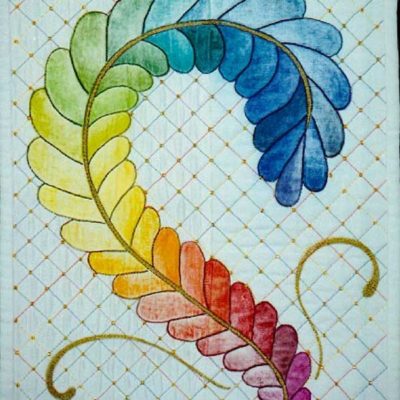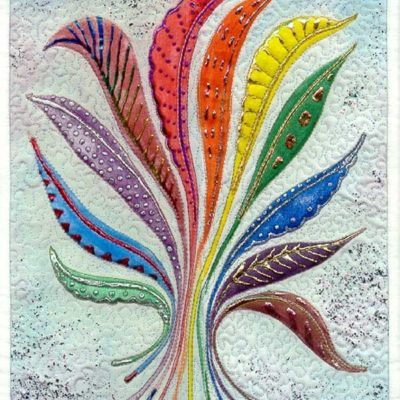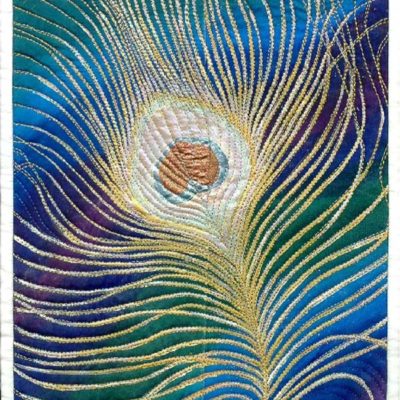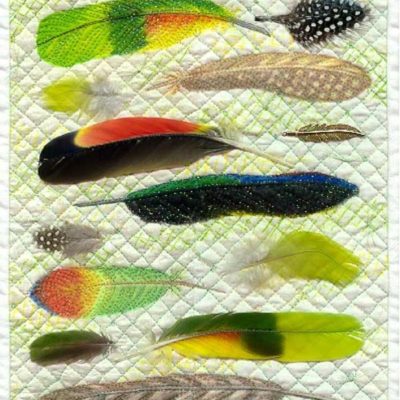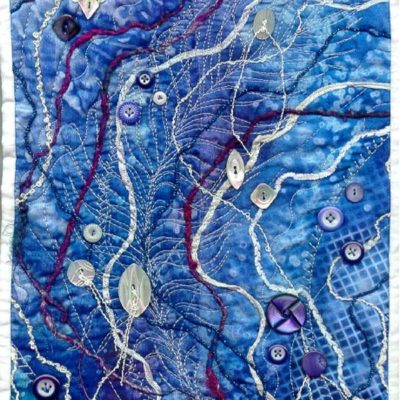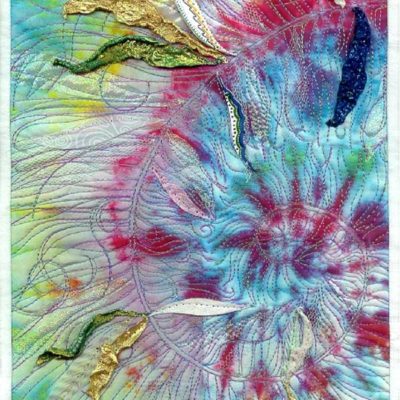January – September 2002, each 8-1/2" wide by 11" high, © 2001, Maria Elkins, All Rights Reserved.
The Journal QuiltPages project was proposed by Karey Bresenhan, Director of the International Quilt Festival. It was to be "a free-form exercise in creativity, specifically planned to encourage quilt artists to stretch and grow." The project was open only to members of the QuiltArt list and the QuiltPages were displayed at the 2002 IQF show. More than 150 members displayed their work.
I wanted to experiment with many different techniques so I chose to make my QuiltPages following these guidelines:
- Each quilt is 8-1/2" wide by 11" high.
- Each quilt has 100% silk fabric on the left and 100% cotton fabric on the right.
- Each quilt uses a different surface design technique.
- Each quilt uses a different thread.
- Each quilt uses a different embellishment.
- Each quilt uses two different battings: one on the top half of the quilt and a second batting on the bottom half.
January
- Comments: This quilt was an extension of QuiltPage 1, using a similar feather motif in an informal balance. After I did this one, I decided to use the feather motif throughout my journal quilts.
- Coloring Agent: Prismacolor pencils. When washed in Synthropol they faded (as shown in the outside feathers). The inside feathers were colored a second time to show what Prismacolor pencils look like unwashed.
- Embellishment: Glass seed beads
- Quilting Thread: Sulky 100% rayon thread, 40 wt.
- Batting on Top Half: Quilter’s Dream Request (100% polyester)
- Batting on Lower Half: Warm & Natural (100% cotton)
February
- Comments: Tsukineko All-Purpose Ink is a relatively new product (to me at least) and I think it has a lot of potential. It is easy to work with and very permanent when heat set.
- Coloring Agent: Tsukineko All-Purpose Ink. Top feather: ink mixed with thickener and applied with a brush; Bottom feather: undiluted inks applied with foam applicator; Background: ink applied to wet fabric
- Embellishment: Glass irridescent bugle beads, gold and silver Lumiere fabric paint
- Quilting Thread: Sulky sliver, metallic and irridescent threads
- Batting on Top Half: Hobbs Heirloom Organic (100% cotton with scrim)
- Batting on Lower Half: Perfect Cotton "Natural" (88% cotton, 12% polypropylene)
March
- Comments: I had received a sample pack of red, blue and gold Createx fabric paints, so I decided to use only those three colors and play with mixing new colors.
- Coloring Agent: Createx Textile Colors. Background was splatter painted and the feathers were stenciled with brush, foam brush, sponge, rag, rubber stamp and other found objects.
- Embellishment: Fusible sequins, fusible rhinestones, fusible nailheads
- Quilting Thread: YLI Reflections thread, Madeira metallic and heavy metal threads
- Batting on Top Half: Mountain Mist Gold-Fuse (50% cotton, 50% polyester)
- Batting on Lower Half: June Tailor Quilter’s Fusible (100% cotton)
April
- Comments: D’Uva Watercolors were another new product I wanted to try. The watercolors are supposed to be "erasable" until heat-set. However, I found they do not erase very well from fabric. The company does have quite a bit of information on how to use them on fabric, though.
- Coloring Agent: D’Uva Erasable Watercolors
- Embellishment: Jones Tones Foils
- Quilting Thread: Valdani 100% cotton, variegated thread (35 weight)
- Batting on Top Half: Yolo Wool Products (100% wool)
- Batting on Lower Half: Nature’s Comfort (100% wool)
May
- Comments: Background was painted with Setacolor and washed without heatsetting. There was very little color loss. Both the Setacolor and the Lumiere paints proved be be very opaque when I painted the lighter colors over the top.
- Coloring Agent: Pebeo Setacolor and Jacquard Lumiere fabric paints
- Embellishment: Sprinklers Premium Fashion Glitter and Pearl-Ex
- Quilting Thread: Madeira Polyneon thread (100% polyester, 40 weight) with a double needle
- Batting on Top Half: Matilda’s Own (60% wool, 40% polyester)
- Batting on Lower Half: Maple Ridge Sheep Farm (100% wool)
June
- Comments: I made this quilt specifically so I could use some real feathers as embellishments. I was also curious about using ordinary crayons on fabric.
- Coloring Agent: Pentel FabricFun Pastel Dye Sticks (top left feather, central black feather, and background); Crayola Crayons (brown feathers and third feather from the bottom left); all have been heatset and washed.
- Embellishment: Feathers and charm
- Quilting Thread: Madeira Opal thread, intentionally quilted crooked with occasional thread tufts at the intersections
- Batting on Top Half: Fiberco Simply Cotton Back to Basics (100% cotton)
- Batting on Lower Half: Fiberco Soft and Elegant (50% cotton, 50% polyester)
July
- Comments: This design was an attempt to do something totally different for me. It is inspired by a close-up photograph of a feather.
- Coloring Agent: Jacquard Dye-na-flow and Jacquard Water Based Resist
- Embellishment: Brass WireMesh, ArtEmboss aluminum, wire, eyelets, glass, sliver threads
- Quilting Thread: Oliver Twists 100% cotton, hand-dyed thread
- Batting on Top Half: Fairfield Cotton Classic (80% cotton, 20% polyester)
- Batting on Lower Half: Hobbs Premium Cotton Blend (80% cotton, 20% polyester)
August
- Comments: Sunprinting with Setacolor is very easy and a lot of fun. Slop the paint on, throw something on top of it, and stick it in the sun. I used different pastas and a needlepoint canvas to print this background. For this quilt, the feather motif is carried out only in the quilted outline of a feather.
- Coloring Agent: Pebeo Setacolor sun printing
- Embellishment: Cotton, rayon and silk yarns with pearl and porcelain buttons
- Quilting Thread: Robison Anton 100% rayon thread (40 weight)
- Batting on Top Half: 100% silk batting
- Batting on Lower Half: Air-Lite Synthetics (80% cotton, 20% wool)
September
- Comments: The spiral tie-dye background provides a backdrop for some unusual embellishment materials.
- Coloring Agent: Procion dye
- Embellishment: Tyvek, mylar, and shrink plastic; mulberry and silk paper; irridescent organdy, tulle, and netting
- Quilting Thread: Aurifil 100% rayon, variegated thread
- Batting on Top Half: Quilter’s Dream Request 100% cotton (low loft)
- Batting on Lower Half: Quilter’s Dream Deluxe 100% cotton (high loft)
These experiments are actually the fulfillment of an idea that I had over twenty years ago, but at the time I was too afraid of failure to try. Now I’m older (and maybe a little wiser) and I’ve come to realize that it’s okay to fail because it teaches me what works and what doesn’t. Ultimately, it’s not the final product that is important, it’s the learning process that matters.
